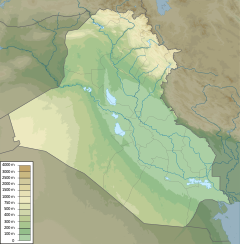|
Ibn Bunnieh Mosque
The Ibn Bunnieh Mosque (Arabic: جامع ابن بنيه), also known as the Hajj al-Bunnieh Mosque (Arabic: جامع الحاج بنية) is a mosque in Baghdad located in al-Karkh district, opposite the Baghdad Central Station and near the Iraq Museum. Its unique Islamic architecture and style include its oval dome which is shaped like an egg and Arabic calligraphy of verses from the Quran on its walls made by the Iraqi master calligrapher Hashem Muhammad al-Baghdadi. The name of the mosque was attributed to Hajj Mahmoud al-Bunnieh who is buried next to the sanctuary from the western side. The mosque can hold 1,000 prayers.[1][2][3] The Ibn Bunnieh Mosque is considered one of the most important urban landmarks of Baghdad.[1] The Mosque was also included in the 1982 official Iraqi Tourist Guide as a significant mosque and a notable landmark recommended for tourists to visit.[4] Historical backgroundConstructionThe intention was to build a luxurious mosque at the crossroads of Baghdad. Qahtan al-Madfai was commissioned to build the mosque; Hajj al-Bunnieh was keen to ensure that the mosque was purely Iraqi in terms of its general character, structure, building materials, and decorations. Foreign materials were avoided in its construction except for steel and electrical materials, which were obtained from the local market. As for the rest of the materials, they are Iraqi and local. The white stone used in construction was brought from Mosul and was cut, polished, and engraved in the work yard. Hajj Mahmoud died in December 1971 but his children carried out their father's will to complete the mosque.[1][5][6] The mosque became located in front of the Alawi al-Hilla bus garage.[7] Establishment and notable events The mosque was completed on May 31, 1974. Its first to ascend the minbar of the mosque was the Egyptian Sheikh named "Mahmoud Muhammad Gharib", who carried out Islamic activities and an Islamic movement in Baghdad, which made the authorities at the time arrest Gharib and then was deported outside Iraq. On February 23, 2006, the mosque was subjected to acts of violence and vandalism, causing material damage to the mosque during the US invasion of Iraq, which led to its closure. Later in April 2007, the mosque was reopened.[1][5][6] During the Iraq War, many buildings around the mosque were in a state of neglect but the mosque survived through with large crowds of wounded and fleeing soldiers stopping by. The mosque also witnessed large crowds of visitors, including worshippers and people coming in to rest or clean themselves in the hammam.[8] In late 2020, the mosque was slightly damaged after a missile, originally a part of nine Katyusha missiles targeting the Green Zone, landed on it. No casualties were reported.[9][10] On July 7, 2022, the mosque saw a large demonstration of contract owners from the Ministry of Electricity marching to the Green Zone demanding the confirmation of the ministry's staff.[11] DescriptionLayout and exteriorThe total area of the Ibn Bunnieh Mosque is 5,000 square meters. The mosque's campus includes a large luxurious mihrab and above the campus is an oval dome with a height of 36 meters and a diameter of 25 meters, decorated with various inscriptions. The mosque also has a high minaret with a height of 55 meters. The minaret has a unique octagonal shape with a diameter of 3 meters, and it is covered with blue tiles brought from Karbala.[1] The outside walls include Qu'ranic verses written and carved in by Hashem Muhmmad al-Baghdadi.[3] InteriorThe mosque contains a large chapel that can accommodate more than 1,000 worshipers along with other rooms such as a library full of Islamic and historical books. The mosque has a residence for the Imam and a large hall for holding religious events and mourning councils. It also contains a chapel for women, a room for administration and servants, and around the sanctuary is a garden and a yard.[1] It also includes stones and tiles with inscribed calligraphy in the Thuluth script which was done by Hashem Muhammad al-Baghdadi.[12] See alsoWikimedia Commons has media related to Ibn Bunnieh Mosque. References
|
||||||||||||||||||||||||||||||||||||||||||

